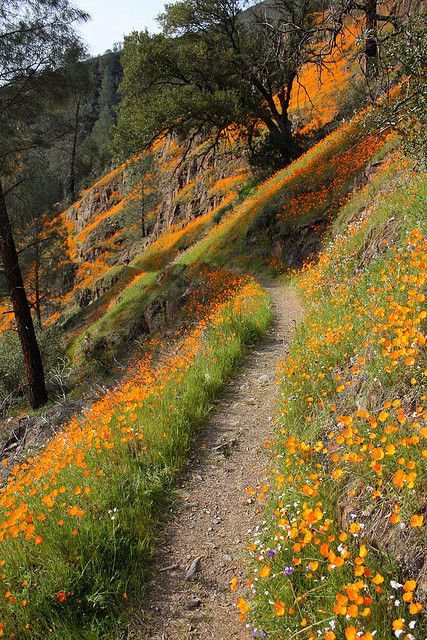John Muir in 1868 wrote of the endless “sea” of wildflowers that blanketed the 450-mile long and 40- to 60-mile wide Great Central Valley in the spring of that year.
“Go where I would, east or west, north or south, (it) still splashed with ripples in flower gems,” Muir noted.
California’s seemingly endless wildflowers also inspired countless authors including John Steinbeck who penned the following excerpt in “East of Eden”:
“On the wide level acres of the valley the topsoil lay deep and fertile. It required only a rich winter of rain to make it break forth in grass and flowers. The spring flowers in a wet year were unbelievable. The whole valley floor, and the foothills too, would be carpeted with lupins and poppies. Once a woman told me that colored flowers would seem more bright if you added a few white flowers to give the colors definition. Every petal of blue lupin is edged with white, so that a field of lupins is more blue than you can imagine. And mixed with these were splashes of California poppies. These too are of a burning color—not orange, not gold, but if pure gold were liquid and could raise a cream, that golden cream might be like the color of poppies.”
Golden Poppies can be found virtually everywhere in California during different times of the year. They pop up along sandy beaches, in fertile valleys, desert lands, rolling foothills and even in the lower elevations of mountains.
It is no wonder it was named the state flower in 1903 when then-Governor George Pardee signed legislation into law. The reservoir bearing Pardee’s name that straddles the Alameda and Calaveras county lines 30 miles east of Stockton is just one of the endless places you can find the California Golden Poppy in bloom in the coming weeks.
The California Golden Poppy is native primarily to California and extends into Oregon, Washington, Nevada and Arizona as well as Sonora and northwest Baja California in Mexico. They have been introduced to other areas in the world with Mediterranean climates, most notably Chile. They also have been successfully imported to Australia, South Africa and Argentina.
The perennial grows between five and 60 inches tall featuring bluish-green foliage. The round lobed segments of flowers typically are in solitary stems with a slight feel of silk. Each flower features four petals.
The petals close at night as well as in cold or windy weather.
Depending upon where you are in California they bloom from February to September.
Wildflower experts indicate it is a potentially invasive species. That said more invasive exotic species such as annual grasses and mustard plants have displaced the poppies in vast segments of Southern California.
It is, by the way, illegal to pick California Golden Poppies on state or federal land. But then again it’s illegal to pick any wildflower on state or federal lands. Such a misdemeanor crime carries a maximum penalty of $1,000.
And for the record, it is illegal to harm plants on property owned by other people unless you have permission to do so.
That leaves the only place you are free to pick Golden Poppies is your own property. However such an effort would be for naught. Within minutes of being picked, their petals start to drop off.
The drought-resistant California Golden Poppies that grow in sandy well-drained soil with plenty of sun are divided into subspecies with some experts even declaring them distinct species.
It is why at times California Golden Poppies appears to be in different hues in different locations.
Golden Poppy enthusiasts have created a list of the Top 10 viewing places for the flower. The largest and most famous of all is the 1,722-acre Antelope Valley Golden Poppy Preserve in the western part of Antelope Valley in Los Angeles County.
There are eight miles of trails in the reserve that is considered the most consistent poppy-bearing land in the state. There are also other wildflowers found there such as lupine, cream cups, owl’s clover, and lupines among others.
There is a $10 vehicle entrance fee for the reserve that is open daily from sunrise to sunset. The wildflower season typically runs from mid-February through May.
The top 10 list includes three Northern California locations. One is remote Bear Valley in western Colusa County and one is Dry Creek Wildflower Meadows in Tulare County. The other is in the 209.
The 209 viewing area is the Merced Valley and Hite Cove.
Actually it is two distinctive areas adjoining each other that have different accesses.
You can see the Merced Valley display from your car. It’s along Highway 140 heading out of Merced toward Yosemite National Park. When the highway runs along the Merced River and as the valley becomes deeper, both sides of the river bank are ablaze in bright orange during the springtime.
Hite Cove is considered one of the of the five best spring hikes in Yosemite National Park as determined by the National Park Service even though it is outside the park boundaries.
The trailhead at 1,900 feet can be reached about 8.5 miles west of the El Portal entrance gate to Yosemite Valley, which can reach in less than two hours via Highway 99 and Highway 140.
The hike is deemed moderate as the 7.2 mile round trip has an elevation gain of only 100 feet but there is a lot of rolling terrain. It typically takes two to five hours based on fitness level.
If you opt to go all the way to Hite Cove it is a nine-mile round trip. The reason to go the extra distance is to get a glimpse of where the south and central forks of the Merced River merge.
The prime time to hike is March through mid-May. It is dependent on how severe the winter has been. By mid-May, even with a wet winter, the flowers are pretty much dying off and it is a lot hotter.
Keep in mind a few things.
Cedar Lodge that offers snacks and drinks is three miles to the east of the trailhead that is located at the site of the historic Savage’s Trading Post. The building no longer serves as a trading post but the sign is easy to spot. There is a portable toilet across the highway from the trailhead where you will also find parking.
There is no fee but keep in mind the first 0.75 miles of the trail goes through private property.
If you slip off the trail there are spots you will get bruised if you fall. There are a few spots where the drop-off could prove deadly during a fall. That said, it isn’t dangerous if you pay attention and remember to be careful when stepping aside to let other hikers pass on what is a one-track trail.
There are also lots of poison oak and a few mosquitoes. You can also come across ticks from time-time. And yes, there are rattlesnakes in the area but they don’t become an issue until spring wears on and the wildflowers are dead.
There is also a lot more to the hike than California Golden Poppies. You will find more than 60 varieties of wildflowers. The most brilliant palettes are typically in March.








